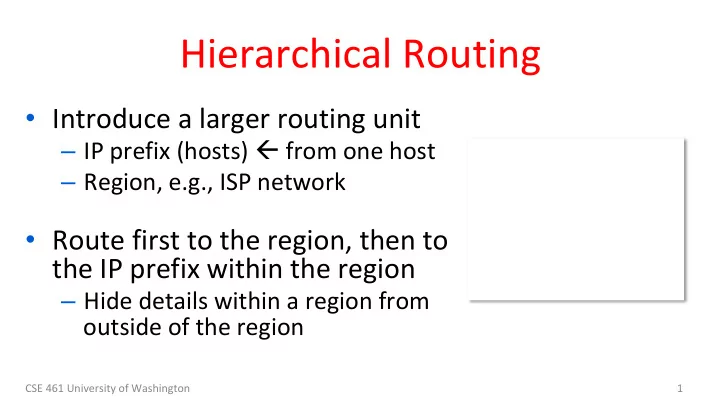

Hierarchical Routing • Introduce a larger routing unit – IP prefix (hosts) ß from one host – Region, e.g., ISP network • Route first to the region, then to the IP prefix within the region – Hide details within a region from outside of the region CSE 461 University of Washington 1
Hierarchical Routing (2) CSE 461 University of Washington 2
Hierarchical Routing (3) CSE 461 University of Washington 3
Hierarchical Routing (4) • Penalty is longer paths 1C is best route to region 5, except for destination 5C CSE 461 University of Washington 4
Observations • Outside a region, nodes have one route to all hosts within the region – This gives savings in table size, messages and computation • However, each node may have a different route to an outside region – Routing decisions are still made by individual nodes; there is no single decision made by a region CSE 461 University of Washington 5
Topic • How to route with multiple parties, each with their own routing policies – This is Internet-wide BGP routing Source ISP B ISP A ISP C Destination CSE 461 University of Washington 6
Structure of the Internet • Networks (ISPs, CDNs, etc.) group hosts as IP prefixes • Networks are richly interconnected, often using IXPs Prefix B1 Prefix D1 Prefix C1 CDN D ISP B IXP CDN C IXP Prefix E1 Prefix A1 Net E IXP IXP Net F ISP A Prefix E2 Prefix A2 Prefix F1 CSE 461 University of Washington 7
Internet-wide Routing Issues • Two problems beyond routing within an individual network 1. Scaling to very large networks – Techniques of IP prefixes, hierarchy, prefix aggregation 2. Incorporating policy decisions – Letting different parties choose their routes to suit their own needs Yikes! CSE 461 University of Washington 8
Effects of Independent Parties • Each party selects routes ISP A ISP B to suit its own interests Prefix A1 Prefix B1 – e.g, shortest path in ISP • What path will be chosen Prefix A2 for A2 à B1 and B1 à A2? Prefix B2 – What is the best path? CSE 461 University of Washington 9
Effects of Independent Parties (2) • Selected paths are longer ISP A ISP B than overall shortest path Prefix A1 Prefix B1 – And symmetric too! • This is a consequence of independent goals and Prefix A2 Prefix B2 decisions, not hierarchy CSE 461 University of Washington 10
Routing Policies • Capture the goals of different parties – could be anything – E.g., Internet2 only carries non-commercial traffic • Common policies we’ll look at: – ISPs give TRANSIT service to customers – ISPs give PEER service to each other CSE 461 University of Washington 11
Routing Policies – Transit • One party (customer) gets TRANSIT service from another party (ISP) ISP Rest of – ISP accepts traffic for customer Internet from the rest of Internet Customer 1 Non- – ISP sends traffic from customer customer to the rest of Internet Customer 2 – Customer pays ISP for the privilege CSE 461 University of Washington 12
Routing Policies – Peer • Both party (ISPs in example) get PEER service from each other ISP A ISP B – Each ISP accepts traffic from the other ISP only for their customers Customer A1 Customer B1 – ISPs do not carry traffic to the rest Customer A2 Customer B2 of the Internet for each other – ISPs don’t pay each other CSE 461 University of Washington 13
Routing with BGP (Border Gateway Protocol) • BGP is the interdomain routing protocol used in the Internet – Path vector, a kind of distance vector Prefix B1 Prefix F1 via ISP ISP B B, Net F at IXP Prefix A1 ISP A IXP Net F Prefix A2 Prefix F1 CSE 461 University of Washington 14
Routing with BGP (2) • Different parties like ISPs are called AS (Autonomous Systems) • Border routers of ASes announce BGP routes to each other • Route announcements contain an IP prefix, path vector, next hop – Path vector is list of ASes on the way to the prefix; list is to find loops • Route announcements move in the opposite direction to traffic CSE 461 University of Washington 15
Routing with BGP (3) Prefix CSE 461 University of Washington 16
Routing with BGP (4) Policy is implemented in two ways: 1. Border routers of ISP announce paths only to other parties who may use those paths – Filter out paths others can’t use 2. Border routers of ISP select the best path of the ones they hear in any, non-shortest way CSE 461 University of Washington 17
Routing with BGP (5) TRANSIT : AS1 says [B, (AS1, AS3)], [C, (AS1, AS4)] to AS2 • CSE 461 University of Washington 18
Routing with BGP (6) CUSTOMER (other side of TRANSIT ): AS2 says [A, (AS2)] to AS1 • CSE 461 University of Washington 19
Routing with BGP (7) PEER : AS2 says [A, (AS2)] to AS3, AS3 says [B, (AS3)] to AS2 • CSE 461 University of Washington 20
Routing with BGP (8) • AS2 hears two routes to B (via AS1, AS3) and chooses AS3 (Free!) CSE 461 University of Washington 21
BGP Thoughts • Much more beyond basics to explore! • Policy is a substantial factor – Can we even be independent decisions will be sensible overall? • Other important factors: – Convergence effects – How well it scales – Integration with intradomain routing – And more … CSE 461 University of Washington 22
Recommend
More recommend